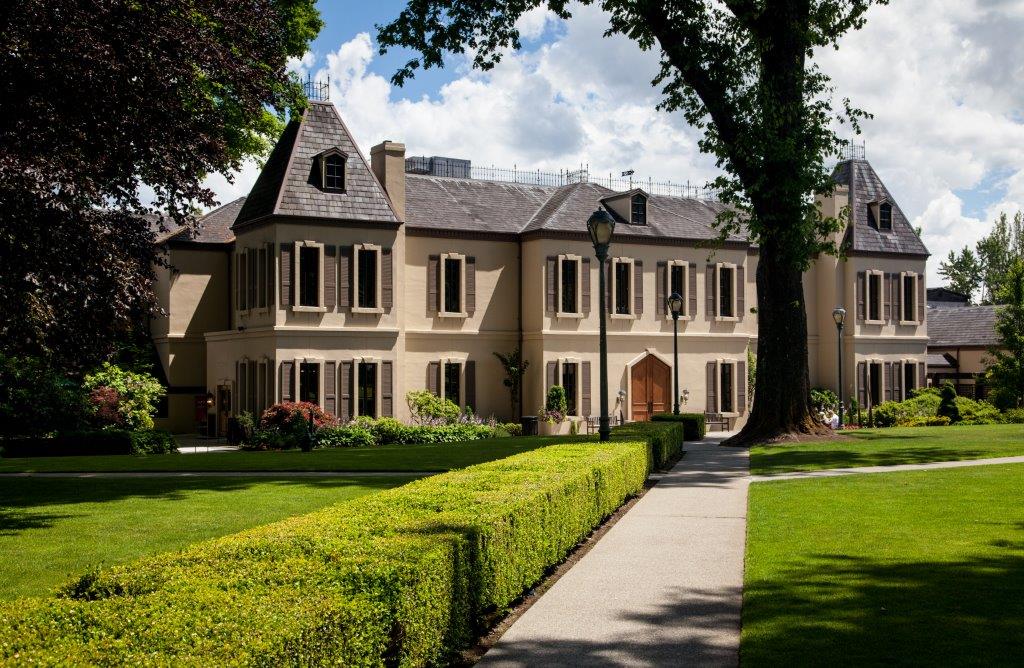It’s evening at Ste. Michelle Estates’ Northstar Winery in Walla Walla, and a group of British and European wine professionals are immersing themselves in the Blending Experience. Everyone has a beaker, a notebook and a spit bucket, plus access to barrels of Merlot, and they’re busy creating their own wine blends.
Northstar’s David “Merf” Merfeld, who looks more like a rock star than a winemaker, explains Walla Walla Merlot to the group: “Here, it’s more like big Cabernets,” he says. “It’s versatile, with a velvety mouthfeel.”
By the time the final blends are bottled, grown men are reaching for coloured pens, so they can create their labels. “Finished!” says a buyer from the UK, proudly holding aloft a bottle covered in hand-drawn stars.
It’s hard not to get excited about wine in the Pacific Northwest corner of the US. Washington currently has 807 wineries and more than 60,000 acres of vines, but it feels on the verge of something even bigger. Companies like E&J Gallo and Jackson Family Wines have been making significant acquisitions in both Washington and Oregon, partly because land prices are lower than in California, and also because the mighty Columbia River means there’s plenty of water available for irrigation. But there’s another factor as well. The wines emerging from this region combine the power and ripe fruit flavours of the New World with the lively acidity and freshness of the Old.
Ste. Michelle Estates, the biggest player in Washington, definitely wants to expand – into European markets. So it’s invited a group of buyers and importers to come and see what they’re doing. There’s also one journalist (me) tagging along. Because if you want to understand a wine company, there’s no better way to do it than to study the reactions of buyers, the people who live or die by the quality of the wines they choose.
Luxury tour
The coach that picks up the group in Seattle is no normal bus. It’s Las Vegas on wheels, with a bar and walls that change colour every few seconds. Our driver is Mr Kawika, looking very cool in dark glasses and suit. “You can charge your phones in the back, and there are Champagne flutes over here!”
Everyone settles in, but there’s not long to enjoy the amenities, because the tour’s first stop is Woodinville, home of Chateau Ste. Michelle. It’s less than an hour from Seattle.
This French-style building, where peacocks roam the lawns, is the biggest and oldest winery in the state. Founded by a lumber magnate, it became part of the National Wine Company in 1934. In 1967 the legendary winemaker André Tchelistcheff came to consult, and Ste. Michelle wines were launched. The winery came to national attention in 1975, when its Riesling came first in a Los Angeles Times tasting; in 1999, Mosel legend Ernst Loosen suggested a joint Riesling project to winemaker Bob Bertheau, Ste. Michelle’s head winemaker. The result was the elegant, award-winning Eroica Riesling.
Inside, a tasting of Chardonnay and Riesling has been set up, followed by a presentation from Sander Vriend, the division manager for Europe. Washington State, he explains, is a cool climate region where the latitudes of France intersect with the longitude of California, although the daily average temperatures are more dramatic. “This gives the wines higher acidity, but more fruit flavour,” he says.
Chateau Ste. Michelle is part of the starry Ste. Michelle Estates portfolio owned by Altria – the giant tobacco company once known as Philip Morris – which buys close to three quarters of all the state’s grapes. “Our CEO, Ted Baseler, calls our group ‘a string of pearls’,” says Vriend, adding that the company wants to become known as “the premier fine wine company in the world”.
Ted Baseler is widely admired in Washington state. Credited with establishing Washington’s reputation, he’s also known for his philanthropy, his commitment to wine education — and his business acumen. According to a recent Press Democrat report, acquisitions, including the purchase of Napa Valley’s iconic Stag’s Leap Wine Cellars in 2007, plus smart management have seen revenues grow 65% from 2004 to 2014, with $643m generated last year. The company accounts for more than half of the state’s production; included in its portfolio are 15 wineries in the Pacific Northwest and five in California, plus partnerships with Marchesi Antinori, Torres, Villa Maria and other premium international wine companies.
“Beautiful wines,” says one of the buyers after the tasting. “These wines will do well in the on-trade,” adds a German buyer. High praise indeed, to suggest a foreign Riesling will do well in Germany.
No expense spared
Red Mountain’s Col Solare is lean and simple, the bell tower an homage to partner Marchesi Antinori. Inside, everything is pristine and expensive looking, including the three barrel halls stuffed with new barrels. The wines here are red blends of Bordeaux varietals. What do the buyers think?
Unfortunately, they’re too tired to chat, and it’s not until the visit to Canoe Ridge Estate the next morning that people start talking again. A smaller facility, it sits in the evocatively named Horse Heaven Hills AVA. Winemaker Ray McKee’s pride and joy is a sorting machine with almost supernatural precision; originally created for blueberry sorting, it will gently blow away stems, or any grapes that aren’t the perfect size and colour. As elsewhere, no expense has been spared; even so McKee is pleased that the plunge in the euro against the dollar has saved $400,000.00 on oak barrels.
After a short tasting – the buyers nodding approvingly when they try the Cabernet Sauvignon – comes a talk by Dr Russ Smithyman, the Ste. Michelle viticultural director. His presentation unfolds like a Hollywood disaster movie: At the end of the last Ice Age, a huge ice block called the Cordilleran Ice Sheet bottled up a lake that covered western Montana. When the ice gave way, a volume of water equivalent to all the rivers in the world today broke through. The Missoula Flood roared through the Pacific Northwest at a rate of 65 mph, tearing down the mountains in their path.
Later, as viticulturalist Mimi Nye shows the group round the Canoe Ridge Estate Cabernet vineyard she planted in 1991, she explains how the floods carved the topography of the region, depositing free-draining soils as they went. The resulting Columbia Valley was left with pockets of land that are particularly well-suited to viticulture.
Columbia Crest
The bus heads further east. Despite the lavish waters of the Columbia River that bisects the landscape, the hills look yellow, dry and brittle. The wildfires burning around the state will eventually cost $200m a week to fight.
Next stop is Columbia Crest, also in the Horse Heaven Hills AVA, and home to 25% of Washington’s production. Its wines are ranged in a carefully considered brand hierarchy, from site-specific Reserve wines to the frankly commercial Moscato. Behind the scenes, inquisitive winemakers are given license to experiment: there’s a clay amphora and concrete egg fermenters in the winery.
Ste. Michelle Estates presents a super-premium face to the world, but it’s also a highly commercial enterprise, as illustrated by the next stop, the 14 Hands Winery. The building conveys a old-style, rustic image, with architecture evoking stables, and a website that waxes lyrical about the mustangs that once galloped freely across Washington; it’s actually a new winery created specifically to support a range of easy-drinking 14 Hands wines.
Guest service manager Krystal Adams explains that the brand was originally created for the on-premise market – until consumers were caught buying it out the back of restaurants, or pretending to have special events so they could order cases. So the company built the winery.
The fresh, lively and keenly-priced wines (around $12.00) mostly get a chorus of approval from the buyers – except for the bestselling Hot to Trot White Blend, which the UK buyers reject on the grounds that white blends do poorly in their market. This sparks a discussion of how Washington should market abroad. By varietal? By origin? The buyers are unanimous: sell them as Washington wines.
Now the conversational doors are open, the buyers are frank. The Malbec will sell well. The Reserve Merlot elicits approval. The extremely sweet Riesling gets a universal and instant “no”.
It’s eye-opening listening to what buyers say among themselves. They talk about how they put wine lists together for restaurants, or how they fill gaps in a client’s list. Wine isn’t just about quality, it’s also about where it sits in the list, and what margin can be made from it. The clear brand hierarchies seem to make creating those lists easier.
Green in the desert
Despite its dry appearance, Walla Walla means ‘many waters’ and the area, which became a recognized AVA in 1984, has long been known for the quality of its fruits and vegetables. Mr K is driving us to one of its jewels: Spring Valley Estate, an oasis of startling green. Tussocky grasses, punctuated by gopher holes, grow between the vine rows on the hills. Below, a tasting has been set up in the cool, green area.
The wines have Dickensian names: Uriah, Derby, Nina Lee. They’re named after members of the Corkrum and Derby families, who came to the valley in the mid-1800s. The first grapes were planted in 1993 by Shari and Dean Derby, and the first wine released in 1999. The wines – Syrah and a cornucopia of red Bordeaux grapes – are fine grained and supple.
Dean Derby, white haired and genial, sits down to tell us his story. “A few years ago, back in 2002, I was on a plane from Seattle to Miami,” he says. “I was sitting next to this guy who was reading a magazine about wine.” The two men got chatting, and the other man gave Derby his card.
Then, tragedy. Derby’s son Devin, their winemaker, was killed in a car accident, leaving the aging Derbys at a loss as to what to do with the winery. “I thought to myself – I met that guy! I’ll give him a call,” says Derby.
The man was none other than Ted Baseler, CEO of Ste. Michelle — who immediately agreed to lease the property, until such time as the family can take it back. “Our relationship with Ste. Michelle has been wonderful,” Derby continues. “They treat us like they’re not here, except the expertise and backup comes from them.” Not only that, but they doubled the salary of French transplant Serge Laville, who’d stepped in after Devin died. “Now Serge is a capitalist,” says Derby.
The buyers are thoughtful as they get back on the bus, this time heading to the airport. Next stop is Napa Valley. But Washington has made its mark.
“Walla Walla wines are great,” says one of the buyers from the back of the bus. The walls slowly flash from red to purple to blue. And people nod.
This article first appeared in Meininger’s Wine Business International.




